
Zoroastrianism or Mazdayasna is one of the world's oldest continuously practiced religions. It is a multi-faceted faith centered on a dualistic cosmology of good and evil and an eschatology predicting the ultimate conquest of evil with theological elements of henotheism, monotheism/monism, and polytheism. Ascribed to the teachings of the Iranian-speaking spiritual leader Zoroaster, it exalts an uncreated and benevolent deity of wisdom, Ahura Mazda, as its supreme being. Historical features of Zoroastrianism, such as messianism, judgment after death, heaven and hell, and free will may have influenced other religious and philosophical systems, including Second Temple Judaism, Gnosticism, Greek philosophy, Christianity, Islam, the Baháʼí Faith, and Buddhism.

A dakhma, also known as the Tower of Silence, is a circular, raised structure built by Zoroastrians for excarnation – that is, for dead bodies to be exposed to carrion birds, usually vultures.

Saddar, also known as Saddar Bazaar, is a neighbourhood in Karachi, Pakistan. The locality was developed as the primary commercial district during the period of British-era rule in Karachi. As a result, Saddar contains the large concentration of colonial-era architecture in Karachi.

Sadeh, is an Iranian festival that dates back to the first Persian Empire, Achaemenid Empire. Sadeh celebrates 50 days before Nowruz. Sadeh in Persian means "hundred" and refers to one hundred days and nights remains to the beginning of spring. Sadeh is a mid winter festival that was celebrated with grandeur and magnificence in ancient Persia. It was a festivity to honor fire and to defeat the forces of darkness, frost, and cold.

Saddar Town, lies in the central part of the city that formed much of the historic colonial core of Karachi. Saddar Town was formed in 2001 as part of The Local Government Ordinance 2001, and was subdivided into 11 union councils. The town system was disbanded in 2011, and Saddar Town was re-organized as part of Karachi South District in 2015.
City Railway Colony is one of the neighbourhoods of Saddar Town in Karachi, Sindh, Pakistan.
Islam Pura is a neighbourhood in District South of Karachi, Pakistan.

Zoroastrians are the oldest religious community of Iran. Prior to the Muslim conquest of Persia, Zoroastrianism was the primary religion of the Persian Empire.

The Great Anti-Buddhist Persecution was initiated by Tang Emperor Wuzong reached its height in the year 845 CE. Among its purposes were to appropriate war funds and to cleanse China of foreign influences. As such, the persecution was directed not only towards Buddhism but also towards other religions, such as Zoroastrianism, Nestorian Christianity, and Manicheism.
Seth Edulji Dinshaw was a Karachi-based Parsi philanthropist during the British colonial era. Dinshaw had risen from poverty, and became the largest landowner in the city.
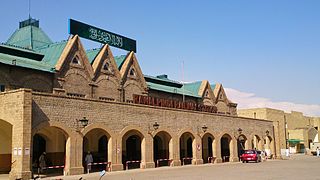
Rawalpindi railway station is located in Saddar area of Rawalpindi, Punjab, Pakistan. It is one of several major stops on the Karachi–Peshawar Railway Line. The nearest Saddar Metrobus Station, part of the Rawalpindi-Islamabad Metrobus is 20 minutes (1.5 km) walk away.
Between the late 19th and early 20th centuries, many wealthy Parsis, began to travel to Iran from Bombay and Gujarat, to revive the Zoroastrian faith and traditions among the stagnating Zoroastrian community in Iran at the time, with prominent personalities such as civil rights activist, Manekji Limji Hateria of Surat gaining local renown.
Bahawalpur Saddar is a tehsil located in Bahawalpur District in the Pakistani province of Punjab. The city of Bahawalpur is the headquarters of the tehsil which is administratively subdivided into 36 Union Councils. The tehsil is traversed by the Hakra depression, south of which lies the desert. The north lies in the Sutlej riverain, and between this and the Hakra are the central uplands.
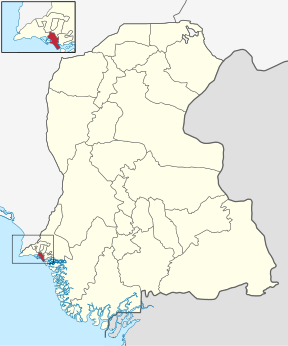
Karachi South District is an administrative district of Karachi Division in Sindh, Pakistan. It is located in the southern part of Karachi.
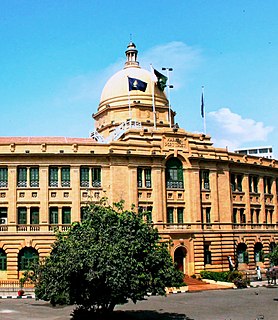
Kharadar is a neighbourhood in District South of Karachi, Pakistan.. Kharadar and the adjacent communities of Mithadar and Jodia Bazaar together form what is regarded as the original core of Karachi.

Zoroastrianism in India has significant history within the country. Zoroastrians have lived in India since the Sasanian period. The Zoroastrians also moved to India in successive migrations during the Islamic period. The initial migration following the Muslim conquest of Persia has been canonized as a religious persecution by invading Muslims. Zoroastrianism meanwhile suffered a decline in Iran after the conquests. Subsequent migrations also took place after the attempts by Safavids to convert their subjects to Shiism.
Laki Shah Saddar railway station is located in Pakistan.
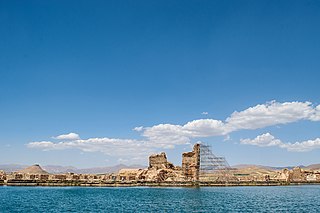
Adur Gushnasp was the name of a Zoroastrian sacred fire of the highest grade, which served as one of the three most sacred fires of pre-Islamic Iran; the two others being the Adur Farnbag and Adur Burzen-mihr. Out of the three, Adur Gushnasp is the only fire whose temple structure has been discovered and "for which archaeological, sigillographical, and textual evidence are all available."
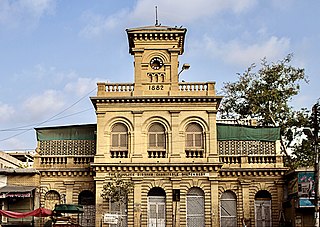
Edulji Dinshaw Dispensary, officially the Eduljee Dinshaw Charitable Dispensary, is a building in the Saddar neighborhood of central Karachi, Pakistan. It was built in 1882, and served as a charitable dispensary for Karachi's citizens. It was named after Karachi-based Parsi philanthropist Seth Edulji Dinshaw, who donated 5,500 rupees towards construction - half of the building's cost. Dinshaw had risen from poverty and became the largest landowner in Karachi at the time. It was designed James Strachan, and was Karachi's first Italianate building.








